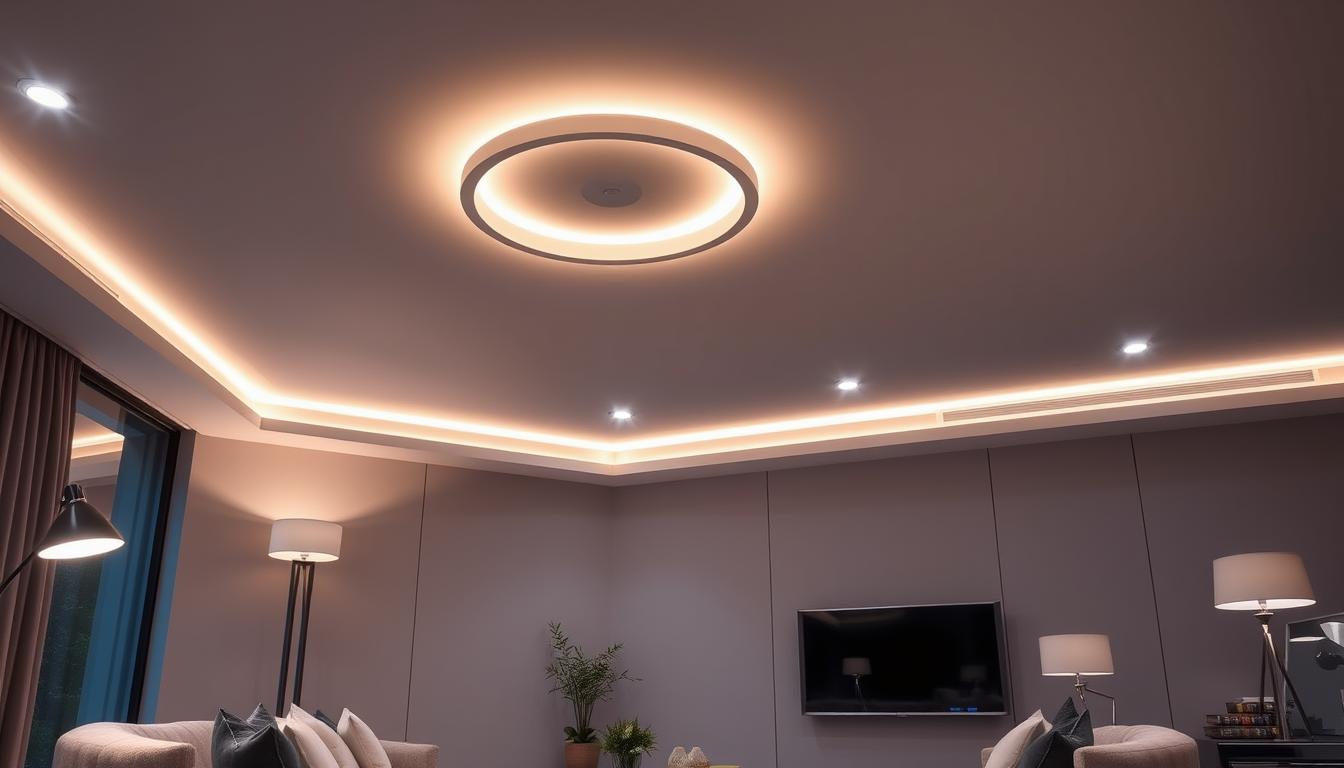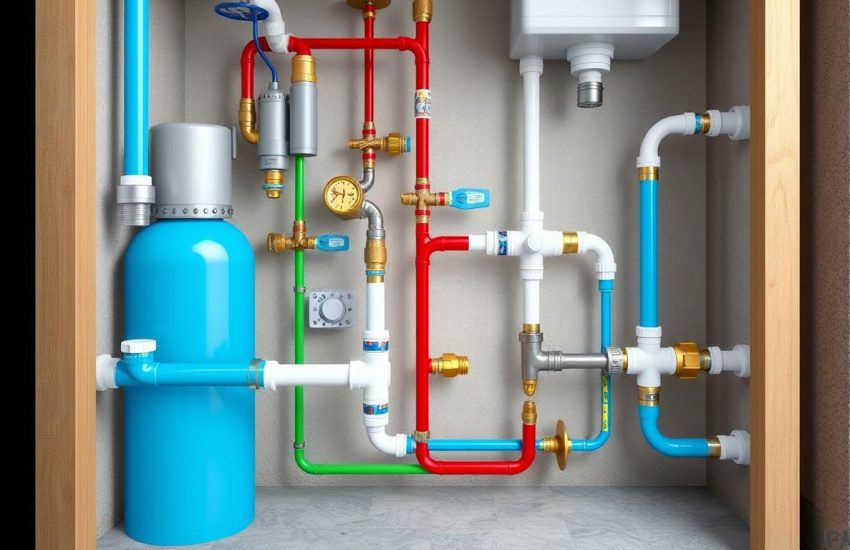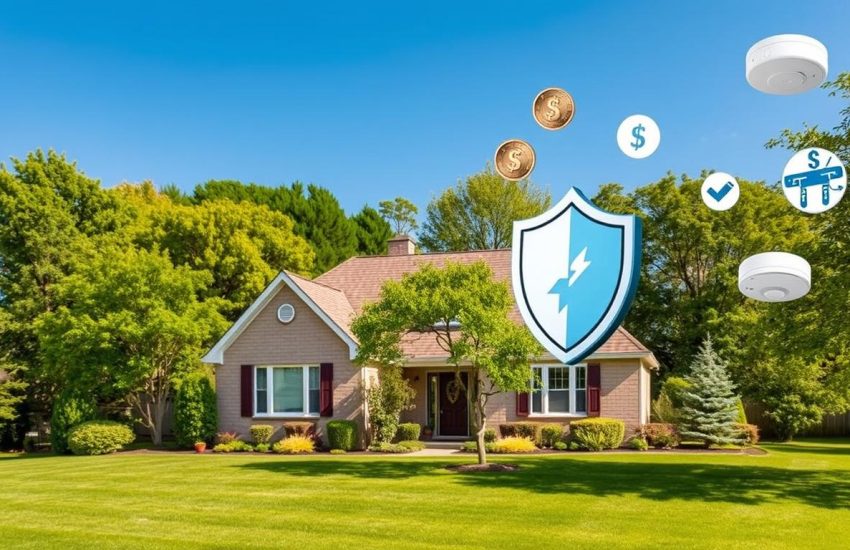Lighting Upgrades: A Complete Guide for Homeowners
As the sun sets, lighting upgrades stand out for home improvement. Today, energy efficiency and modern lighting technology matter a lot. Homeowners choose smarter, brighter options. It’s not just better light—these changes also lower your bills and may increase your home’s value. Have you thought about smart home automation? It can really show what your home can do. If not, now is the time to explore lighting upgrades.
A well-placed chandelier or handy under-cabinet lights are key. They improve your home’s design and efficiency. Switching to LEDs or adding lighting controls can also change your home’s feel and use. But it’s more than looks; choosing eco-friendly upgrades is smart too.
Key Takeaways
- LED lights save energy and last longer than old bulbs.
- Smart lighting systems add convenience with remote control and schedules.
- Updated outdoor lighting boosts your property’s look and value.
- Switching to LEDs or CFLs cuts energy costs and can increase your home’s price.
- DIY or hiring a pro, lighting upgrades make your home smarter and more efficient.
Get ready for a guide to make your home shine brightly. These upgrades are good for your pocket, comfort, and the planet. What’s next? Decide if you want to do it yourself or hire help. We’ll cover the advantages of each choice, making your journey to better lighting easy.
Why Focus on Lighting Upgrades?
Lighting upgrades in your home offer many perks. They make your home more comfy each day. They also add to your home’s value. Choosing eco-friendly lighting is good for our planet. It brings cost savings and energy efficiency, too.
Modern lights like LEDs save you money over time. They cut down on your energy and repair bills. LEDs last up to 100,000 hours, much longer than old lights. This means you don’t have to replace them as often.
Enhanced ambiance is another benefit. Lights can make your living room cozy or your kitchen bright. You can change them to fit your mood or what you’re doing. This makes your home nicer to live in.
Upgrades can also increase your home’s value. A well-lit home draws in buyers and might sell for more. Eco-friendly and efficient homes are becoming more popular. This makes modern lighting a smart choice.
LED lights are better for the environment, too. They use much less energy than old lights and are fully recyclable. This can make a big difference in your carbon footprint.
Let’s see some facts about the impact:
| Technology | Energy Savings | Lifetime | Recyclability |
|---|---|---|---|
| LEDs | 90% less energy | Up to 100,000 hours | 100% recyclable |
| Fluorescent Lamps | Degrades to 70% output quickly | 20,000 hours | Contains mercury, harder to dispose |
So, with all these great reasons, like saving money, having an eco-friendly home, enjoying a better ambiance, and a possible value increase, why wouldn’t you upgrade your lighting?
DIY vs Professional Help
Homeowners deciding between DIY lighting upgrades and professional installation face a big choice. This choice involves factors like complexity, safety, and cost. Simple tasks such as changing light bulbs or adding simple fixtures can be DIY. Yet, complex setups like smart lighting systems need a pro.
- LED upgrades can cut your power bills a lot.
- Smart home gadgets may need more power, so you need an expert to look at it.
- Going pro can make your home safer and might boost its value, which is a big plus.
Let’s talk money. DIY lighting kits from places like Home Depot cost about $200-$400. But, professional setups from Volt Lighting can cost $1,500-$2,000. These offer better quality and warranties.
| Source | DIY Cost | Professional Cost |
|---|---|---|
| Home Depot | $200-$400 | — |
| Volt Lighting | $1,500-$2,000 | $4,000 for 15 lights |
| Costco | More cost-effective online options | — |
Doing it yourself might seem good. But hiring a pro is key for safety and following the law. For example, you might need a permit for installing EV chargers. Going pro avoids risks and makes sure everything is done right
Having lights installed by pros looks better and works better. Plus, you get great warranties and help later on. This is something DIY can’t give you.
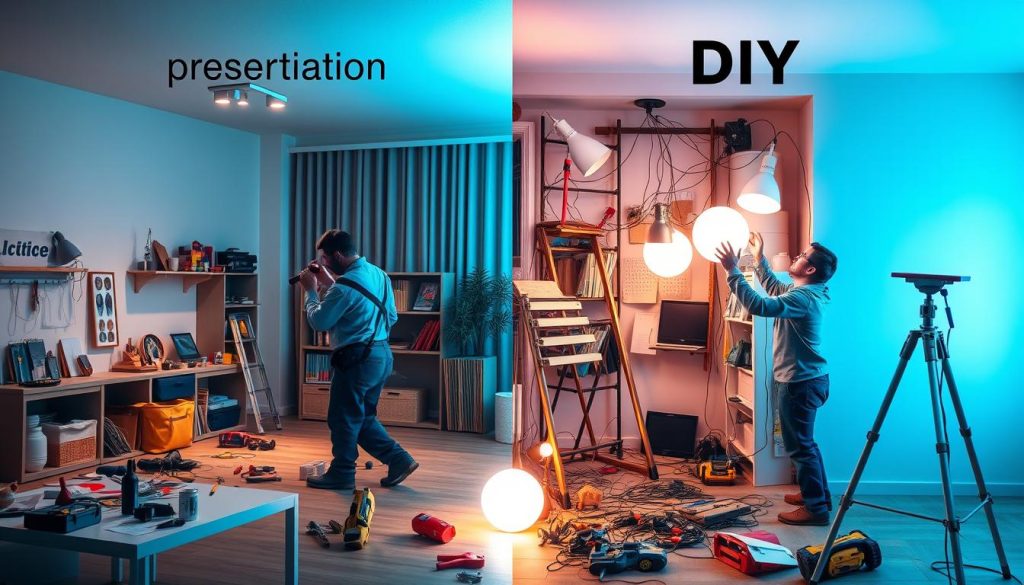
In the end, DIY lighting upgrades can save you money at first. But, for bigger or more complex projects, professional installation is better. It’s safer, follows the rules, and adds value to your home. It’s worth the cost.
How to Save Money
Choosing affordable lighting upgrades can lower your energy bills. This also makes your home look better. Lighting makes up about 15% of a home’s yearly energy costs. So, switching to LED lights and looking into utility rebates is smart.
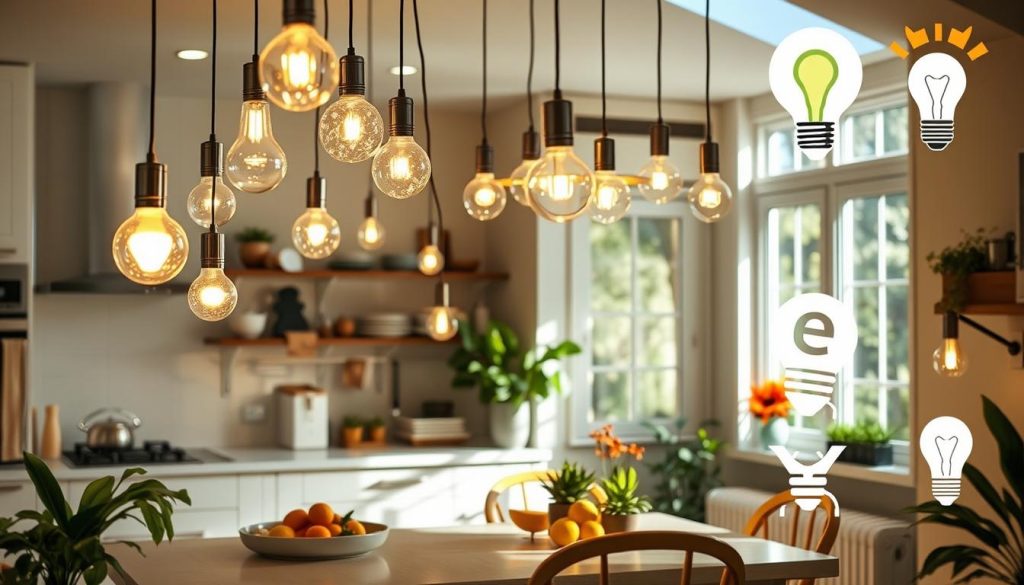
LED lights use about 90% less energy than old bulbs. They last way longer too. You will save on energy and not have to change bulbs often. LEDs don’t make much heat. This means you also save money on cooling.
If you plan to upgrade a lot of lights, LED utility rebates are helpful. Companies like Avista give rebates for switching to LEDs. They also help pay for big changes, like adding motion sensors. This makes sure lights are only on when needed.
- Initial Replacements: Start by replacing old bulbs with LEDs to save energy.
- Enhanced Controls: Use sensors and timers to save even more energy.
- Utilize Rebates: Check out utility rebates for indoor and outdoor lights.
- Monitor Progress: Keep track of how much energy you save and adjust as needed.
Turning off lights when you leave helps save energy. Keeping windows clean lets in more sunlight, saving more money. Small steps and big changes can really lower your bills. With LED utility rebates, making your lighting better is affordable for everyone.
Step-by-Step Upgrades
Enhancing your home with a lighting upgrade process is exciting. It’s not just about new bulbs. It also means choosing lights that fit your lifestyle and look good. Here’s how to do it step-by-step:
- Lighting Options Evaluation: First, look at your current lights and compare them to LED ones. LEDs use 90% less energy and are just as bright. This saves money and energy. Checking your lights can show you which ones aren’t working well.
- Consultation and Customization: Talking to experts can help a lot. They can check your lights and tell you about LEDs. They talk about colors, brightness, and if they dim. This helps make your home look just right.
- Financial Planning: LEDs save money in the long run. They last longer, meaning fewer changes. There might be special deals that save you even more, like $249 per light.
- Installation: After picking your lights and planning, it’s time to put them in. This might include smart lighting integration. This type of system changes light based on the time of day or what you’re doing.
- Performance Evaluation: After everything is set up, check that it all works right. See if you’re saving energy and if you like the new lights. Make sure it’s all how you wanted.
| Feature | Benefit |
|---|---|
| LED Energy Efficiency | Uses 90% less energy, matching brightness of conventional bulbs |
| LED Longevity | Lasts 15 times longer, reducing replacement frequency |
| Cost Savings | Up to $249 savings per fixture through rebates |
| Customization | Adjustable color temperature and brightness settings |
| Smart Integration | Responsive systems adaptable to user’s environment |
For the best outcomes, think about both use and look. This makes your home efficient and nicer to be in. For tips on keeping your home systems in top shape, like when to check your HVAC, go to scheduling HVAC inspections.
Final Tips for Success
As you finish your lighting upgrades, remember some key tips. Use LED lighting to save energy. LEDs are much more efficient than traditional lights. Automated controls can also save you energy. They change the light based on time, if people are around, or the outside light. This is what the experts suggest for different places.
Choosing the right LED lighting color is important. The color temperature can affect how we feel. For instance, warm light might make breakrooms cozy. Cool light keeps work areas bright and alert. Don’t forget about security lighting. Using motion sensors and floodlights is smart. They make places safer and save energy, especially outdoors. The lighting mood should match the room’s use and what you want to feel.
Talk to experts before you start. This way, you can choose the best lights for each area. Also, keep track of what lights you have now and how old they are. Changing all the lights at one time keeps them working well. And, be smart about how much you think you’ll save. LEDs do save a lot of energy. But, it’s good to be realistic about the savings.
Last thoughts, lighting upgrades do more than just switch on a light. Keep checking your lights and fix them when needed. As your company changes, so should your lighting. This helps protect your money spent on lights. Good lighting is key. It makes places easier to see and helps everyone feel better and work well.

